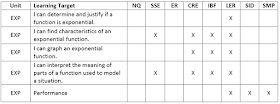I was thinking this is pretty awesome! How can I make it better? How can I use it to create a cohesive lesson on unit conversions. I got another good idea from Gregory Taylor (@mathtans) that I would like to incorporate as well:
At TMC, I got to talking a little more with Anna, and we had BOTH been trying to find a way to make the conversions a little more manipulative for students. I was still thinking numbers, but Anna thought shapes! And the beauty of shapes is that I can choose ones with symmetry, so that each fraction could be turned either way!!! This to me was the awesome part.
So with a lot of trial and a little error, I created some cards that can be used to intro how dimensional analysis needs to be set up to cancel one thing and leave another. Here are the "conversion factors"
There are 6 of them, but they could all be flipped the other way, making 12 possible options for students to choose from. I also made cards to be the start and end of the conversion. Nothing too exciting to see here:
Then I played around to make sure I had enough of everything, but not too much. And I think I do. I like that sometimes there is only one solution, and sometimes there are three. At this point my plan for this activity would be to show the start and end I would like on my document camera and have students work in pairs. Then if they find a solution I will prompt, "Can you find another?" Sometimes they will be able to and sometimes not. Hopefully some students will be able to justify why they can or cannot find another solution.
I played around a lot with it and I don't want to put all the pictures here, because I tried to find all the solutions, but here are a few:
Start with a square and end with a hexadecagon has at least two solutions, but start with a octagon and end with a rhombus only has one.
Obviously this is not an entire lesson, so I still have some more planning to do, but I like what I've got so far and I think it will give my students some good playing and thinking about math opportunities. I am trying to collaborate with the science teacher on this standard, so I've got a lot to do before I can be all the done thinking about it.
I have some other notes on what the rest of the lesson might be like, but really this next part is for me, so skip to the comments and throw questions or concerns up there. I'll post links to the docs at the bottom too!
Notes for Me:
- Me: Shape manipulatives
- Science: Number manipulatives
- Think Input/Output (where input/output have the same value/amount/quantity)
- Me: discuss conversion factors need to have a value of 1
- What can we multiply by without changing the value of the input?
- Science: look up conversion rates
- Me: notes
- Science: guided practice
- Mistakes? Video? Student created mistakes?
- Should we make an assignment menu? Due for both classes? Revision encouraged throughout?
- I want students to journal after doing the shape manipulating! Need a good prompt.
- Introduce new shape. Create one conversion factor that will allow you to convert this shape to any other shape in your set. How do you know this works? Maybe it doesn't, but you're close. How do you know it doesn't work?
Here are the documents:
Let me know what you think!
-Kathryn
















